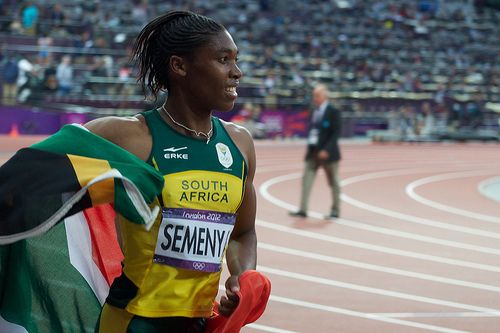
Image Credit: Jon Connell, Flickr
If you don’t already know, Caster Semenya won the gold medal in the Women’s 800 meter race Saturday at the Rio Olympics. She blew past the competition in the last stretch, finishing with a time of 1:55.28 and almost a 1.5 second lead on the silver medalist.
She set a national record, earned the fifth-fastest time in Olympic history, and became the first South African woman to win gold for her country in Olympic athletics in 64 years. If you don’t know Caster Semenya, here’s why you should.
She Dreams Big
You should know her because she’s a dreamer, living proof that hard work is the secret ingredient to achieving what seems impossible. “Every athlete’s dream is to win a medal, especially in the Olympics,” she said after her 800 meter win on Saturday.
Semenya grew up in the Limpopo province of South Africa. She has loved sports since she was a child, playing soccer as just a four-year-old and running competitively by age 12. The fiery spirit—and talent—of a champion were undeniable to everyone around her.
She started out training barefoot, running through the South African bush with her fellow runners. She had no fear, racing both the girls and the boys. Coaches saw instantly her spark of greatness.
By 18, she was a world champion. At the 2009 world track and field championships in Berlin, Semenya dominated the 800 meter race and won by more than 2 seconds. At the 2012 London Olympics, Semenya won the silver medal. Ever since, she’s only grown hungrier for gold.
She Does Not Quit
Despite being one of the most amazing female athletes that track and field has seen, she’s also been one of the most brutally scrutinized by the media.
I want no part in the invasion of another human’s life. I refuse to further besmirch this woman’s name, like those who fear her greatness. I see only that Caster Semenya has something to teach us—and I thought you should know.
After Semenya became a world champion at 18, a fellow competitor called her a man. The general secretary of the International Association of Athletics Federations (IAAF), Pierre Weiss, ignorantly said, “She is a woman, but maybe not 100 percent.”
The IAAF then temporarily banned Semenya from competition—as in, they told the fastest living woman in the 800 meters that she couldn’t race. But Semenya didn’t make a scene, she respected the rules, and, above all, she never stopped training.
She Believes in Respect
Semenya was shaken, but didn’t stop her in the pursuit of greatness. The ban was indefinite and kept getting extended, but she continued training with her coaches and running mates in South Africa. Despite missing training sessions on her sad days and coaches seeing her motivation lack as she waited to race again, Semenya always picked herself back up and kept running.
After becoming the 2009 world champion. IAAF subjected Semenya to “sex verification tests.” What the heck is that, you may ask? Me too.
The protocol for sex verification in female athletes begins with a hormone screen, testing for elevated testosterone levels. If testosterone levels are above average, medical examiners need to see how much of it is “functional”—meaning how much testosterone actually binds to the woman’s receptors and creates an advantage.
Men and women compete separately in athletic competition, largely because of the advantage testosterone gives men—a performance boost of about 10 to 13 percent. Testosterone is also a hormone used for doping purposes.
Sex verification also involves more crude measurements: how hoarse her voice is, the growth of her pubic hair and breasts, her muscle size, along with an up-close-and-personal examination of her vagina and its parts.
In the Kuchu Times’ documentary Too Fast to Be a Woman? The Caster Semenya Story, Semenya talks about respect: “The most important thing is respect. If you respect your parents or everybody—actually you must respect each and every person. You have been seeing what’s been happening…So, you call that respect?” She lets out a pfft, her eyes widen. “I don’t call it respect.”
She is a Pioneer for Human Rights, Gender Roles
Ross Tucker, professor of exercise physiology at the University of the Free State in South Africa, told NPR about the history of sex verification tests. In the 1960s, Olympic officials sought to identify male athletes posing as women. In order to compete, female athletes had to pass an examination in front of a panel of doctors and receive a “Certificate of Femininity.”
In 1985, Maria Jose Martinez Patiño from Spain was an emerging force in the Women’s 60 meter hurdles when she failed sex test. She was asked to feign an injury and retire, and then asked not to compete in the 1986 Spanish National Games—but she refused and won gold. After, her sex test results were leaked to the press, she was stripped of her title, and banned from all competition. By the time she won the two-year fight for reinstatement, she was no longer able to qualify for the Olympics. Her story is an eerie reminder of what could have happened to Semenya.
Tucker is appalled by the ignorant responses to Caster Semenya’s race performances, calling her “he,” “him,” and even “it.” He sees racism at play in this controversy, and says “the only reason she’s being questioned is because she doesn’t conform to a Western perception of what a woman should look like.”
Since 2005, there have been at least 8 cases of “gender issues” raised by the IAAF. Four of those women were asked quietly to end their careers. Only Caster Semenya has been publicly named and humiliated.
In the Face of Disrespect, She shows Grace
Like all medical history reports, Semenya’s sex verification test results were supposed to be private and confidential, but they were leaked to the press.
Reports said her testosterone levels were three times as high as most women— which has not been verified—and gave far-too-intimate details about her anatomy. As a high-profile athlete and South African celebrity, Semenya endures an insane amount of media coverage. Yet, even celebrities are granted a few, fundamental privacies—like the details of their reproductive organs—unless they make that information public themselves. But no such respect has been shown to Caster Semenya.
She’s now called an “intersex” athlete, referring to the 1 in about 1,500 people who are bon with sex anatomy variations that differ from what most consider “normal.” The issue raised by intersex athletes is the perceived advantage that women with higher testosterone levels have in competition.
Some women have a condition that’s called hyperandrogenism, producing naturally higher levels of testosterone. In 2011, IAAF enacted a policy that restricted female athletes from competition if their testosterone levels were above 10 nanomoles per liter (nmol/L). To compete, IAAF required them to bring their testosterone levels down below the normal range for men—meaning invasion with risky hormone-suppressing drugs and even surgery to remove internal testes.
The average female ranges from 0.5 to 2.5 nmol/L of testosterone. The average male? An incredibly wide range of 10 to 38 nmol/L of testosterone. For both male and female athletes alike, this level is bound to be higher because of intensive training regimens and low body fat content.
Despite our normative understandings of gender, there’s no singular measure of what’s “normal.” What exactly makes a man more “manly,” or a woman more of a woman? But society tries to tell us just that and delineate us into concrete categories. Without even an inkling of Olympic greatness in me, former classmates still found reasons to bring my gender into question, mocking the appearance of my dark hair as “sideburns” and a “mustache.” In terms of both human biology and individual personality, gender is indeed a spectrum.
The media and her fellow athletes seem to forget that Caster Semenya is a human. She’s a young woman who somehow remains brave in the face of blatant hatred and questions about her identity. Before her gold-medal winning race in Rio, she tweeted this quote: “Rumors are carried by haters, spread by fools, & accepted by idiots.
She’s A Once-in-a-Lifetime Athlete
Competitors and sport officials try to keep Semenya from running, but there’s no stopping her incredible human potential.
Last year, the IAAF rule was suspended. The Court of Arbitration for Sport was “unable to conclude that hyperandrogenic female athletes may benefit from such a significant performance advantage that it is necessary to exclude them from competing in the female category.”
No evidence proves that testosterone gives a greater competitive edge than that of nutrition regimens, quality training, and other genetic and biological factors. Yet, some reporters and competitors insistently accuse Semenya.
After the 2009 world championships, fellow competitor Elisa Cusma Piccione of Italy commented, “For me, she is not a woman…It is useless to compete with this, and it is not fair.” After Semenya’s win in Rio, Lynsey Sharp of Great Britain—who took sixth and failed to medal—broke into tears in an interview and said, “It is out of our control. We rely on people at the top sorting it out.”
Olympic athletes fascinate us because they are exceptional. All champions have something uniquely, mystically great about them—an advantage of their biology or psychology that drives them to greatness.
When Usain Bolt powers to the front of his races, smiling back at competitors as he crosses the finish line, we call him the greatest of all time. Asbel Kiprop of Kenya amazes us in long-distance races, yet we don’t shame him for his naturally long, thin legs, nor blame him for living in a place where he trains at altitude. When Michael Phelps won his 28 Olympic medal, we did not rob him of victory by investigating whether he’s on the upper end of “normal” male testosterone levels.
Semenya won the gold medal in Rio because she is exceptional. After the race, she told BBC Sport what she thinks about her haters: “They’re building your strength. They’re making you a better person. People should learn how to unite. Sport is all about uniting people and not discriminating. I feel sorry for them.”
She Knows Who She Is
We’ve all wanted to be the best, to be champions in our own right. I empathize with the runners who decry Semenya’s advantages, only because I, too, have come in second place, or sixth place, or didn’t even make the cut because I wasn’t tall enough or fast enough.
We are each born with a unique biology, special gifts, and inherent advantages. Life is strange and unfair, which is why we must celebrate greatness when we see it. Caster Semenya is great, even when the world tells her she isn’t. She teaches us that respect is a human right, who you are is a rare gem, and it is only impossible until it’s done.
The universe bestowed Caster Semenya with biological gifts—along with Usain Bolt, Asbel Kiprop, Michael Phelps, and so many champions. But what’s Semenya’s view on the matter?
“The way you were born is the way you were born. There’s nothing that can change it. Yeah, I’ve got a deep voice, I know. I might look tough, so what are you going to do? Do you think you can change it? No. If someone was born the way she was born—or he was born—are you going to go and blame him? Or are you going to blame God? Huh? Who’s fault is that?” She chuckles. “Nobody’s.”
You can watch a documentary about Caster Semenya’s life on YouTube: Too Fast to Be a Woman? The Story of Caster Semenya
